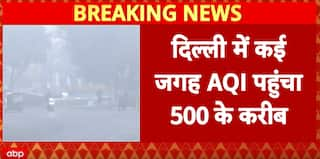Delhi Pollution: Capital Enveloped In Thick Smog Layer Ahead Of Diwali As Air Quality Remains 'Very Poor'
The national capital witnesses increasing pollution levels, particularly as winter approaches and the annual smog season sets in.

The area in Delhi-NCR remained covered in a thick layer of smog on Wednesday morning as the air quality index (AQI) continued to be 'very poor'. The AQI of the national capital was recorded at 354, according to the System of Air Quality and Weather Forecasting And Research (SAFAR). A higher value of AQI means an increase in air pollution.
The deterioration in air quality led to prompting enforcement of Stage II of the Graded Response Action Plan (GRAP) in the national capital, which enforces a ban on the use of coal and firewood, including tandoors in hotels, restaurants, and open eateries, as well as diesel generator sets, except for emergency and essential services. In a measure to control dust pollution, mechanical sweeping and water sprinkling on identified roads will also be carried out on a daily basis. Dust control measures will be enforced at construction and demolition sites.
The national capital witnesses increasing pollution levels, particularly as winter approaches and the annual smog season sets in. In another step to curb the rising air pollution, the New Delhi Municipal Corporation (NDMC) has doubled the parking charges in the Lutyens area of the city.
"Keeping in view the climatic conditions, the parking fees (off road/indoor) have been enhanced to twice of the existing fees for the parking managed by NDMC till the revocation of stage II of the GRAP," the NDMC order said. The enhancement of parking charges will not be implemented for the on-street parking sites and monthly pass holders. The NDMC has directed for strict compliance of the order with immediate effect.
Under the normal parking charges for surface parking at the NDMC parking lots, four-wheelers are charged Rs 20 per hour (with a maximum of Rs 100 for a day), while two-wheelers are charged Rs 10 per hour. In the case of multilevel parking sites, the charges are Rs 10 for four hours for cars and Rs 5 up to four hours for two-wheelers. For the Municipal Corporation of Delhi (MCD), which manages around 96 per cent of the city's geographical area, the parking charges have not been hiked so far.
Check out the table below for the AQI readings at the major air quality monitoring stations in Delhi at 9 AM on Tuesday.
| Station | AQI |
| ITO | 276 |
| Jahangirpuri | 417 |
| Jawaharlal Nehru Stadium | 297 |
| Lodhi Road | 297 |
| Major Dhyan Chand National Stadium | 358 |
| Mandir Marg | 355 |
| Mundka | 373 |
| NSIT, Dwarka | 379 |
| Najafgarh | 342 |
| Narela | 357 |
| Nehru Nagar | 365 |
| North Campus, DU | 365 |
| Patparganj | 373 |
| Punjabi Bagh | 365 |
| Pusa | 305 |
| RK Puram | 352 |
| Rohini | 388 |
| Sirifort | 334 |
| Bawana | 391 |
| Sonia Vihar | 322 |
| Sri Aurobindo Marg | 322 |
| Wazirpur | 387 |
| Alipur | 372 |
| Anand Vihar | 402 |
| Ashok Vihar | 359 |
| Burari Crossing | 391 |
| Dwarka | 367 |
| IGI Airport | 367 |
AQI between 0 and 50 is considered 'good', 51 to 100 is considered 'satisfactory', 101 to 200 is considered 'moderate', 201 to 300 is considered 'poor', 301 to 400 is considered 'very poor' and 401 to 500 is considered 'severe'.






































